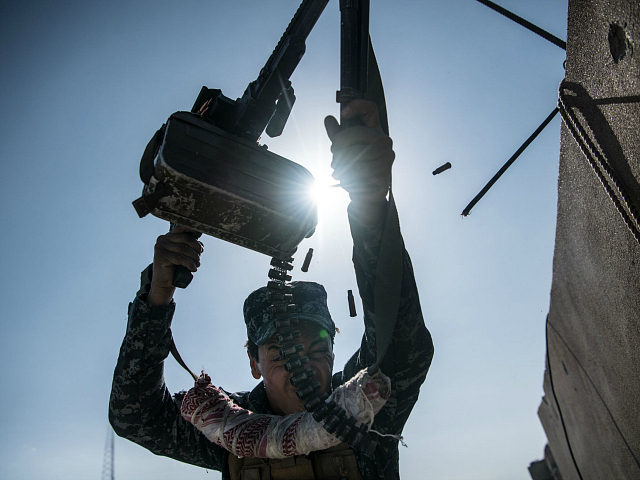WASHINGTON, DC — Some American taxpayer-funded weapons sent to Iraq to combat the Islamic State (ISIS/ISIL) may have ended up in enemy hands as a result of the U.S. Army’s failure to properly track and secure the military equipment, Pentagon officials told lawmakers.
Among the military equipment the U.S. has sent to Arab and Kurdish fighters in Iraq to fight ISIS are ammunition, M16 rifles, M14 sniper rifles, 12-gauge shotguns, and military vehicles.
Iran-backed Shiite militias affiliated with the Baghdad-sanctioned Popular Mobilization Forces (PMF) or Popular Mobilization Units (PMU), may have also gotten their hands on the equipment the U.S. Army lost.
PMU troops, also known as al-Hashd al-Shabi, were linked to American casualties before the rise of ISIS and have threatened U.S. forces after.
Nevertheless, the Shiite troops have cooperated with American troops in Iraq.
During a hearing Tuesday, Col. David Navratil, the country director for Iraq in the Pentagon’s office for Middle East Policy, told the House Armed Services Subcommittee on Oversight and Investigations:
Some equipment, U.S. equipment bought for ISF [Iraq security Forces] has more than likely found its way into enemy hands … and I don’t want to lump all the PMU into enemy, but some of them have strong Shiite backing and strong Iranian ties.
…
We deal with these issues infrequently, but when we do we treat them very seriously because we’re putting a lot of money into this country.
Col. Navratil also told lawmakers there is “a lot of pressure” from U.S. Secretary of Defense Jim Mattis to get the equipment back, adding that there is “probably a year or two” left until the U.S.-backed local forces “eradicate” ISIS in Iraq.
His comments came after officials from the Government Accountability Office (GAO) and the Department of Defense (DOD) office of the Inspector General (IG) told the House panel that the U.S. Army is losing track of anti-ISIS war equipment funded by America’s Iraq Train and Equip Fund (ITEF).
The U.S. military keeps its equipment for the Iraqis’ fight against ISIS in Iraq and Kuwait where the DoD IG found the U.S. Army has failed to properly secure thousands of pieces of equipment, including weapons.
In Iraq, the U.S. military kept ITEF weapons at a storage site “that had a perimeter fence with multiple holes large enough to allow unauthorized access,” wrote Michael Roark, an assistant DoD IG, in his written testimony.
Meanwhile in Kuwait, “weapons were stored in cardboard boxes, some of which had holes in them, or had partially collapsed,” he added. “Weapons were also stored in wooden crates that were not banded or locked. As a result, we were able to open numerous boxes and expose their contents.”
Although the U.S. Army was unable to provide “complete data for the quantity and dollar value of equipment on hand, including vehicles and ammunition,” the DoD IG was able to determine how much equipment the American military kept in Iraq and Kuwait as of October of last year.
He testified:
There were over 11,400 ITEF weapons, valued at $17.7 million, in Kuwait, and over 2,900 ITEF weapons, valued at $2.3 million, at the site in Iraq we visited. Examples of these weapons include M16 rifles, M14 sniper rifles, and 12-gauge shotguns. Overall, we found that the Army did not have effective procedures for conducting inventories and securing ITEF weapons in Kuwait and Iraq.
Congress authorized the creation of the ITEF fund to provide equipment and other assistance to Iraq’s security forces, including Kurdish and tribal fighters, to take on ISIS.
Late last year, Baghdad legalized the Iran-allied PMU as a component of the Iraqi military. According to the Pentagon, the U.S. has only provided assistance to PMU troops vetted against links to Iran and terrorism.
“As of December 2016, DOD had disbursed about $2 billion of the $2.3 billion Congress appropriated for ITEF in fiscal years 2015 and 2016 to purchase personal protective and communications equipment, weapons, and vehicles for these forces,” revealed Jessica Farb of the GAO in her written testimony.
Roark noted that of the estimated $2 billion, the Army’s use of non-automated spreadsheets fueled the increased “risk for human-error” that contributed to the lack of accountability for about $1 billion worth of military equipment.
The U.S. Army “did not have accurate, up-to-date records on the quantity and location of ITEF equipment. The use of manually populated spreadsheets increased the risk for human-error when inputting and updating data for equipment worth over $1 billion,” the DOD IG official added.
Congress charged GAO auditors with examining whether the Pentagon accurately maintains track over ITEF-funded equipment from acquisition through transfer to Baghdad or northern Iraq’s autonomous Kurdistan Regional Government (KRG).
It “found that DOD maintains limited visibility and accountability of ITEF-funded equipment,” adding that “DOD cannot fully account for ITEF-funded equipment transfers [to intended recipients] because of missing or incomplete transfer documentation.”

COMMENTS
Please let us know if you're having issues with commenting.